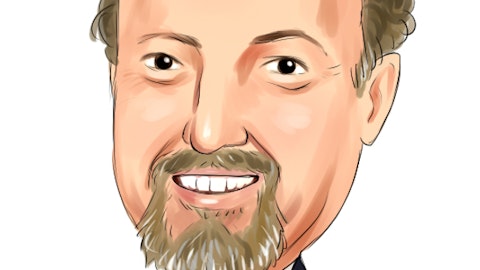Mitch Ingles : This is Mitchell Ingles on for Bobby Griffin. I hope you’re all well. So to start, could you give us an update on your Canadian operations? How do you see the Carquest and Worldpac Canadian operations fit into your long-term plans? With the recent ForEx impact, is this business overall dilutive today to your performance? And how should we think about ForEx exposure going into 2023?
Tom Greco : We see a lot of opportunity with our Canadian business. We made a big investment up there in the distribution center that is now carrying the Worldpac and Carquest parts. It is not dilutive to our overall business. It is a strong performing business. And we believe that we’re going to be able to grow that business significantly as we’ve made a pretty big change up there in Ontario, which is the largest market. You mentioned the ForEx, I mean, obviously, it dropped down to a level that we haven’t seen in a while. But over time, there’s a lot of room for growth for us up in Canada, and we’re going to continue to drive that growth. And we expect 2023 to be a very strong year up there. We’ve got the largest assortment of parts in Southern Ontario in that building. So a combination of OE parts from Worldpac, our owned brand portfolio of DieHard and Carquest, it’s a great national brand. So optimistic about Canada for 2023.
Mitch Ingles : Got it. And then as a follow-up, as you now expand your store footprint again this year, fastest growth in eight years, how should we think about the comp sales benefit as these new stores grow into your comp base? And should we expect similar opening cadence next year?
Jeff Shepherd: Yes. I mean, we’re working through our store count for next year, but our plan is to expand our footprint. We think we have a number of opportunities both in terms of infill where we have a lot of density in areas where we have a lot of opportunity, namely out West. So we’re going to work through that. In terms of comp, we absolutely expect that to give us a lift next year. It does take time. These stores generally reach their maturity over a 3- to 4-year time frame. So we expect that to be an ongoing benefit, as we continue to open stores, it will continue to build on to our comp store base. .
Operator: Your next question comes from the line of Chris Bottiglieri with BNP Paribas.
Chris Bottiglieri : So first one is like just given the competitive dynamics in Pro and you’re unhappy as to market share dynamics, I wonder if you could consider the idea that focusing on margin expansion could be a distraction that is offsetting a lot of your hard work and significant accomplishments. Have you considered adjusting the TSR algorithm to focus on EBIT dollar growth rather than rate?
Tom Greco : Well, we’ve always had a balanced approach, Chris, to this topic. I mean there are three levers to our TSR equation: finishing in the top quartile in 2021 was driven by sales growth, margin expansion and returning excess cash. This year, we clearly have not performed at the sales level that we would have liked, particularly over the last 2 quarters. So as we look ahead, we’re factoring that into the equation. But over time, we still have a very significant opportunity to expand margins. Margins remains very, very important. And we’re not adjusting how we’re looking at building long-term shareholder value, which remains significant for Advance. And that’s a combination of driving sales growth, making sure that our margins continue to expand over time and returning excess cash. So the equation will remain the same, and we will continue to target top quartile TSR growth. .
Chris Bottiglieri : Got you. And then a follow-up question on kind of price investments. It seems like your peers have taken price investments. I think both have lower Pro mix than you do. And it seems like the gross margin headwinds, at least for one of them, seem to be somewhere in the 75 basis point to 100 basis point headwind rate. How do you think about the level of price investment and margin reinvestment you need to make comparable price investments? Are there certain categories where you feel like you’re further behind and you don’t need quite as much of a price investment? Like how do you just frame the size of this investment?
Tom Greco : Good question, Chris. I mean, we use the word surgical for a reason. The tools that we’ve built and the team that we have to manage pricing is at the highest level we’ve ever had in this company. And we are very confident that we can make decisions here that are right for the business. And that includes removing unnecessary discounts where it makes sense, redeploying resources to our highest growth and largest strategic customers and then, at the same time, making surgical price investments in very specific categories and even in the case of stores. So the analysis we’ve done has been very granular. And we know where we need to make those price investments. Our overall goal continues to be priced to cover margin rate.
That is the goal. Obviously, the competitive environment plays a role in how that will unfold next year, and we intend to be very thoughtful about how we price relatively speaking. But it remains — our goal remains price to cover rate, and we’ll see how that unfolds.





